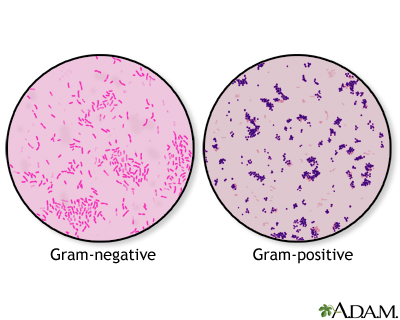Gram stain of skin lesion
Definition
A Gram stain of a skin lesion is a laboratory test that uses special stains to detect and identify bacteria in a sample from the skin. The Gram stain method is one of the most commonly used techniques to quickly diagnose bacterial infections.
Alternative Names
Skin lesion Gram stain
How the Test is Performed
Your health care provider will remove a sample of tissue from the skin sore (lesion). This can be done with a simple swab (bacterial culture) or with a biopsy. If you have a biopsy, your provider will numb the area of skin so you don't feel anything.
The sample is sent to a laboratory. There, it is applied in a very thin layer to a glass slide. A series of different colored stains is applied to the sample. The stained slide is examined under a microscope to check for bacteria. The color, size, shape, and organization of the cells help identify the germ causing the infection.
How to Prepare for the Test
No preparation is needed for the laboratory test.
How the Test Will Feel
There will be a sting when the anesthetic is given. You should only feel pressure or discomfort similar to a pinprick during the biopsy.
Why the Test is Performed
Your provider may order this test if you have signs of an infected skin sore. The test is done to determine which bacteria caused the infection.
Normal Results
The test is normal if no bacteria are found.
Normal value ranges may vary slightly among different laboratories. Some labs use different measurements or test different samples. Talk to your doctor about the meaning of your specific test results. Other tests may be done to help diagnose the problem.
What Abnormal Results Mean
An abnormal result means bacteria have been found in the skin lesion. Further tests are needed to confirm the results. This allows your provider to prescribe the appropriate antibiotic or other treatment.
Risks
Risks of a skin biopsy may include:
- Infection
- Scar
You will bleed slightly during the procedure.
Considerations
A skin or mucosal culture may be done along with this test. Other studies are often done on a skin sample to determine if cancer is present.
Viral skin lesions, such as herpes simplex, are examined by other tests or a viral culture.
Gallery

References
Dinulos JGH. Bacterial infections. In: Dinulos JGH, ed. Habif's Clinical Dermatology. 7th ed. Philadelphia, PA: Elsevier; 2021:chap 9.
Wojewoda CM, Stempak LM. Medical bacteriology. In: McPherson RA, Pincus MR, eds. Henry's Clinical Diagnosis and Management by Laboratory Methods. 24th ed. Philadelphia, PA: Elsevier; 2022:chap 57.